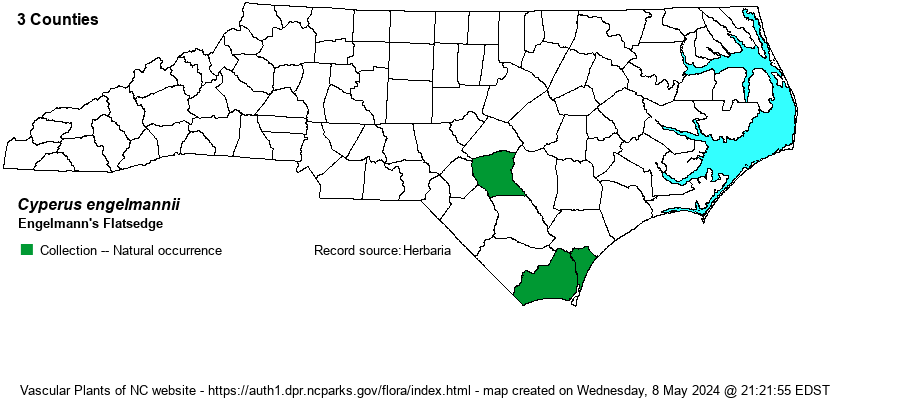| Author | Steudel | |
| Distribution | So far as is known, middle Coastal Plain (eastern Cumberland County) and southern outer Coastal Plain Brunswick and New Hanover counties. Weakley (2022) considers this as a valid species, but see Taxonomic Comments.
MA to southern Ont. and NE, south to SC and MO. | |
| Abundance | Rare. The NCNHP has this taxon on its Watch List. | |
| Habitat | "Wet roadside ditch" (Cumberland County); "ballast near bridge over Northeast Cape Fear River" (New Hanover Co.); "Greenbank Bluff on Cape Fear River" (Brunswick Co.). | |
| Phenology | Flowering and fruiting July-October. | |
| Identification | Cyperus odoratus in the field looks similar to other species with branched inflorescences, but it differs in one major way. When fruits are mature, each seed breaks off from the spikelet with a scale and a small portion of the rachis (stalk of the spikelet). Our other spikesedges, when mature, merely drop seeds without anything else attached. C. engelmannii differs from var. odoratus by longer seeds (1-1.5 mm vs. 1.5-2). | |
| Taxonomic Comments | Cyperus odoratus is a pantropical and warm-temperate species with much variation. Many authors, including FNA, do not recognize infraspecific taxa. Weakley (2022) treats the former var. engelmannii as a full species, but Taxon Editors have questions whether this taxon merits elevation to full species status. Even NatureServe does not consider this entity as a valid species or even a valid variety of C. odoratus.
The genus Cyperus is mostly tropical and warm-temperate in distribution; thus, in NC it is much commoner in the Coastal Plain than in the Mountains and Piedmont. Most species have 1-few flowering stems (culms) from grasslike basal leaves, plus a few stem leaves. At the summit is an inflorescence of very open and branched, or tightly packed, spikes, varying among species from brown to golden brown to straw-color to reddish. The arrangement of the spikelets is important, whether like a hand (digitate) or in paired rows (pinnate); as is the shape of the achene (seed), whether bi-convex in cross-section or triangular. As a group, Cyperus tends to be weedy and readily enters disturbed ground; this is true for many natives as well as all the aliens. In recent years, following DNA research, the genus has incorporated several genera that in RAB (1968) or other manuals were separate: Hemicarpha, Lipocarpha, and Kyllinga. | |
| Other Common Name(s) | | |
| State Rank | S1? | |
| Global Rank | G4Q | |
| State Status | W7 | |
| US Status | | |
| USACE-agcp | | |
| USACE-emp | | |

